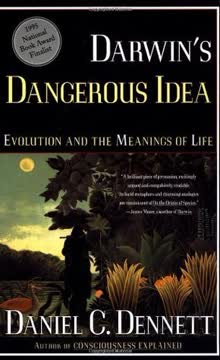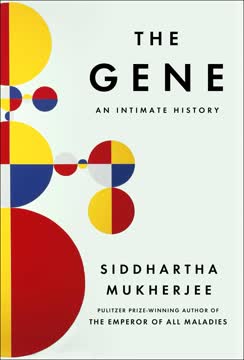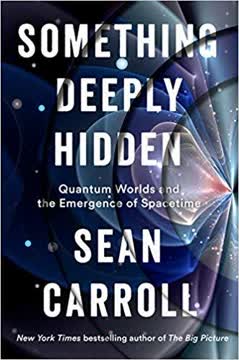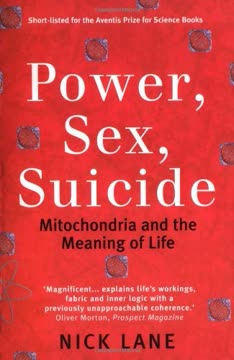Key Takeaways
1. Life's origin: Alkaline hydrothermal vents as cradles of complexity
Rock, water and CO2: the shopping list for life.
Alkaline hydrothermal vents provide the ideal conditions for life's origin:
- Continuous flux of reactive molecules (H2 and CO2)
- Natural proton gradients across thin, catalytic barriers
- Microporous structure for concentrating organic molecules
- Persistence over geological timescales
These vents offer a plausible scenario for the emergence of life that is consistent with thermodynamic principles and universal across the cosmos. The combination of geological features and chemical gradients in these environments could have driven the formation of proto-cells and the first metabolic pathways, setting the stage for the evolution of more complex life forms.
2. The universal importance of proton gradients in cellular energetics
Essentially all living cells power themselves through the flow of protons (positively charged hydrogen atoms), in what amounts to a kind of electricity – proticity – with protons in place of electrons.
Chemiosmotic coupling, the use of proton gradients to drive cellular processes, is a fundamental and universal feature of life:
- Found in all domains of life (bacteria, archaea, and eukaryotes)
- Drives ATP synthesis via the ATP synthase enzyme
- Enables efficient energy conversion and storage
This mechanism's universality suggests it arose very early in life's history and has been conserved due to its efficiency. The ability to harness proton gradients allows cells to store energy in a form that can be readily used for various cellular processes, from biosynthesis to active transport.
3. Endosymbiosis: The key event in eukaryotic evolution
On one single occasion, here on earth, bacteria gave rise to eukaryotes.
The endosymbiotic event that led to the formation of eukaryotes was a singular and transformative moment in life's history:
- Involved an archaeal host cell engulfing a bacterial endosymbiont (proto-mitochondrion)
- Occurred only once in 4 billion years of evolution
- Enabled the development of complex cellular structures and large genomes
This event broke through the energetic constraints that had limited prokaryotic evolution, allowing for the emergence of larger, more complex cells. The integration of the endosymbiont as mitochondria provided eukaryotes with a more efficient energy-generating system, enabling the evolution of complex traits and multicellularity.
4. Mitochondria: More than just powerhouses of the cell
Mitochondria are just as good at making ATP as their free-living ancestors, but they reduced the costly bacterial overheads massively.
Mitochondria's role extends far beyond energy production:
- Enable larger genomes and cellular complexity
- Involved in cell signaling and apoptosis
- Central to the evolution of sex and two sexes
The acquisition of mitochondria allowed eukaryotes to expand their genomes and develop complex cellular structures. By outsourcing energy production to these specialized organelles, cells could dedicate more resources to other functions. Mitochondria also play crucial roles in cellular processes like programmed cell death and have shaped the evolution of sexual reproduction.
5. The chimeric nature of eukaryotic genomes
At the level of our genomes, it seems that all eukaryotes are monstrous chimeras.
Eukaryotic genomes are a mosaic of genes from different sources:
- Roughly 75% of genes with prokaryotic homologs are of bacterial origin
- About 25% are of archaeal origin
- Many genes are unique to eukaryotes ("signature genes")
This chimeric nature reflects the complex evolutionary history of eukaryotes, involving the integration of genes from both the archaeal host and the bacterial endosymbiont. The acquisition of bacterial genes through endosymbiosis and subsequent gene transfer to the nucleus provided eukaryotes with new genetic material for innovation and adaptation.
6. Sex and two sexes: Evolutionary solutions to mitochondrial challenges
Sex is needed to maintain the function of individual genes in large genomes, whereas two sexes help maintain the quality of mitochondria.
Sexual reproduction evolved as a solution to genetic challenges posed by large genomes and mitochondrial inheritance:
- Allows for recombination and repair of nuclear genes
- Uniparental inheritance of mitochondria (typically maternal) maintains mitochondrial quality
- Two sexes emerged as a way to optimize mitochondrial inheritance
Sexual reproduction enables the shuffling of genetic material, helping to eliminate deleterious mutations and combine beneficial ones. The evolution of two distinct sexes, with one typically passing on mitochondria and the other not, helps to prevent conflicts between different mitochondrial populations and maintain mitochondrial function over generations.
7. Mitonuclear compatibility: A driver of speciation and longevity
The copepods suffer a bombardment of genetic parasites from their own endosymbionts.
Mitonuclear compatibility, the coordinated function of mitochondrial and nuclear genes, influences various aspects of evolution:
- Plays a role in speciation through hybrid incompatibility
- Affects lifespan and aging rates
- Influences aerobic capacity and metabolic efficiency
The need for mitochondrial and nuclear genomes to work together efficiently creates evolutionary pressures that can lead to reproductive isolation between populations, potentially driving speciation. Species with high aerobic demands, like birds, tend to have stricter requirements for mitonuclear compatibility, which correlates with longer lifespans and lower rates of mitochondrial DNA mutation.
8. Free radicals: From theory to nuanced understanding in aging
Free radicals act like smoke: eliminate the smoke and you don't solve the problem.
The role of free radicals in aging is more complex than originally thought:
- Act as important cellular signaling molecules
- Can promote mitochondrial biogenesis and improved function
- Excessive antioxidant supplementation may be counterproductive
While the original free radical theory of aging proposed that oxidative damage accumulates over time, causing cellular dysfunction, current understanding recognizes the nuanced role of free radicals. They serve as important signals for cellular maintenance and adaptation. The body's ability to respond to and manage these signals, rather than simply eliminating them, appears to be crucial for healthy aging and longevity.
Last updated:
FAQ
What's The Vital Question about?
- Exploring life's origins: The book investigates why complex life evolved from simple cells, focusing on the evolutionary gap between prokaryotes and eukaryotes.
- Energy's role in evolution: Nick Lane highlights the significance of energy flow and proton gradients in developing cellular complexity.
- Challenging existing theories: It critiques traditional views like the primordial soup hypothesis, proposing alkaline hydrothermal vents as potential life incubators.
Why should I read The Vital Question?
- Insightful perspective: Lane offers a unique viewpoint on life's evolution, integrating biochemistry, geology, and evolutionary biology.
- Addresses fundamental questions: The book explores profound questions about existence and the constraints that shaped life's evolution.
- Engaging writing style: Lane's narrative makes complex scientific concepts accessible and engaging for a general audience.
What are the key takeaways of The Vital Question?
- Life's singular origin: Complex eukaryotic cells arose only once in 4 billion years through a unique endosymbiotic event.
- Energy constraints: Eukaryotes have significantly more energy per gene than prokaryotes, explaining their complexity.
- Proton gradients are essential: Natural proton gradients drive biochemical processes necessary for life.
What are the best quotes from The Vital Question and what do they mean?
- “There is a black hole at the heart of biology.” Highlights gaps in understanding life's evolution from simple to complex forms.
- “We don’t know why life took the peculiar course that it did.” Reflects the lack of consensus on life's unique trajectory.
- “The biggest questions in biology are yet to be solved.” Encourages exploration of unresolved issues in understanding life.
How does The Vital Question explain the origin of eukaryotic cells?
- Endosymbiotic theory foundation: Eukaryotic cells originated from a symbiotic relationship between prokaryotic organisms.
- Gene transfer and loss: Genes from engulfed prokaryotes transferred to the host cell's nucleus, reducing the mitochondrial genome.
- Energetic advantages: The endosymbiotic relationship allowed the host cell to harness energy more efficiently.
How does energy play a role in the evolution of life according to The Vital Question?
- Energy as a driving force: Energy flow, particularly through proton gradients, is essential for driving metabolic processes.
- Energy constraints on prokaryotes: Prokaryotes have less energy per gene, limiting their potential for complexity.
- Proton gradients and metabolism: Natural proton gradients facilitate biochemical reactions necessary for life.
What is the evolutionary black hole mentioned in The Vital Question?
- Lack of understanding: Refers to the gap in knowledge about how complex eukaryotic cells evolved from simpler ancestors.
- Absence of intermediates: No known evolutionary intermediates between bacteria and eukaryotes complicate understanding.
- Implications for biology: Suggests current models of evolution may be incomplete, calling for reevaluation.
What role do mitochondria play in the evolution of complex life according to The Vital Question?
- Energy production: Mitochondria generate ATP through aerobic respiration, crucial for cellular processes.
- Genomic interaction: Mitochondrial and nuclear genomes must work in harmony for optimal cellular function.
- Apoptosis and selection: Mismatches between genomes can trigger apoptosis, ensuring only compatible cells survive.
How does The Vital Question challenge traditional views of life's origins?
- Critique of primordial soup: Argues against the primordial soup hypothesis, emphasizing energy requirements.
- Emphasis on energy dynamics: Shifts focus from information to energy and metabolism in life's development.
- Call for new frameworks: Advocates integrating energy dynamics with evolutionary biology for a comprehensive understanding.
What is the significance of alkaline hydrothermal vents in The Vital Question?
- Potential origin of life: Proposed as ideal environments for life's origin, providing conditions for organic molecule formation.
- Energy and carbon flux: Vents offer a continuous flow of reactive carbon and energy, essential for biochemical processes.
- Natural proton gradients: Vents create gradients crucial for powering metabolic processes and synthesizing ATP.
How does The Vital Question relate to the concept of hybrid breakdown?
- Mitonuclear incompatibility: Occurs when mismatched mitochondrial and nuclear genomes reduce offspring fitness.
- Examples in nature: Hybrid breakdown in species like copepods and fruit flies illustrates genome incompatibility effects.
- Evolutionary consequences: Drives speciation by reinforcing reproductive barriers, highlighting mitonuclear coadaptation importance.
What predictions does The Vital Question make about the future of life on Earth and beyond?
- Rarity of complex life: Complex life forms are likely rare due to specific conditions required for their emergence.
- Potential for life elsewhere: Life on other planets may exist but is more likely to be simple and prokaryotic.
- Implications for future research: Encourages exploration of life's origins and conditions necessary for complexity.
Review Summary
The Vital Question explores the origins of complex life through biochemistry and bioenergetics. Lane argues that energy constraints shaped cellular evolution, proposing alkaline hydrothermal vents as the likely birthplace of life. He examines how endosymbiosis led to eukaryotes and discusses the evolution of sex and death. Readers praise Lane's enthusiasm and insights but note the book's technical complexity. While some find it challenging, many consider it a groundbreaking work that offers a new perspective on life's fundamental questions and evolution.
Similar Books










Download PDF
Download EPUB
.epub digital book format is ideal for reading ebooks on phones, tablets, and e-readers.







